If you buy through our links, we may earn an affiliate commission. This supports our mission to get more people active and outside.Learn about Outside Online's affiliate link policy
The Best Road Running Shoes for Training and Racing (Fall 2025)
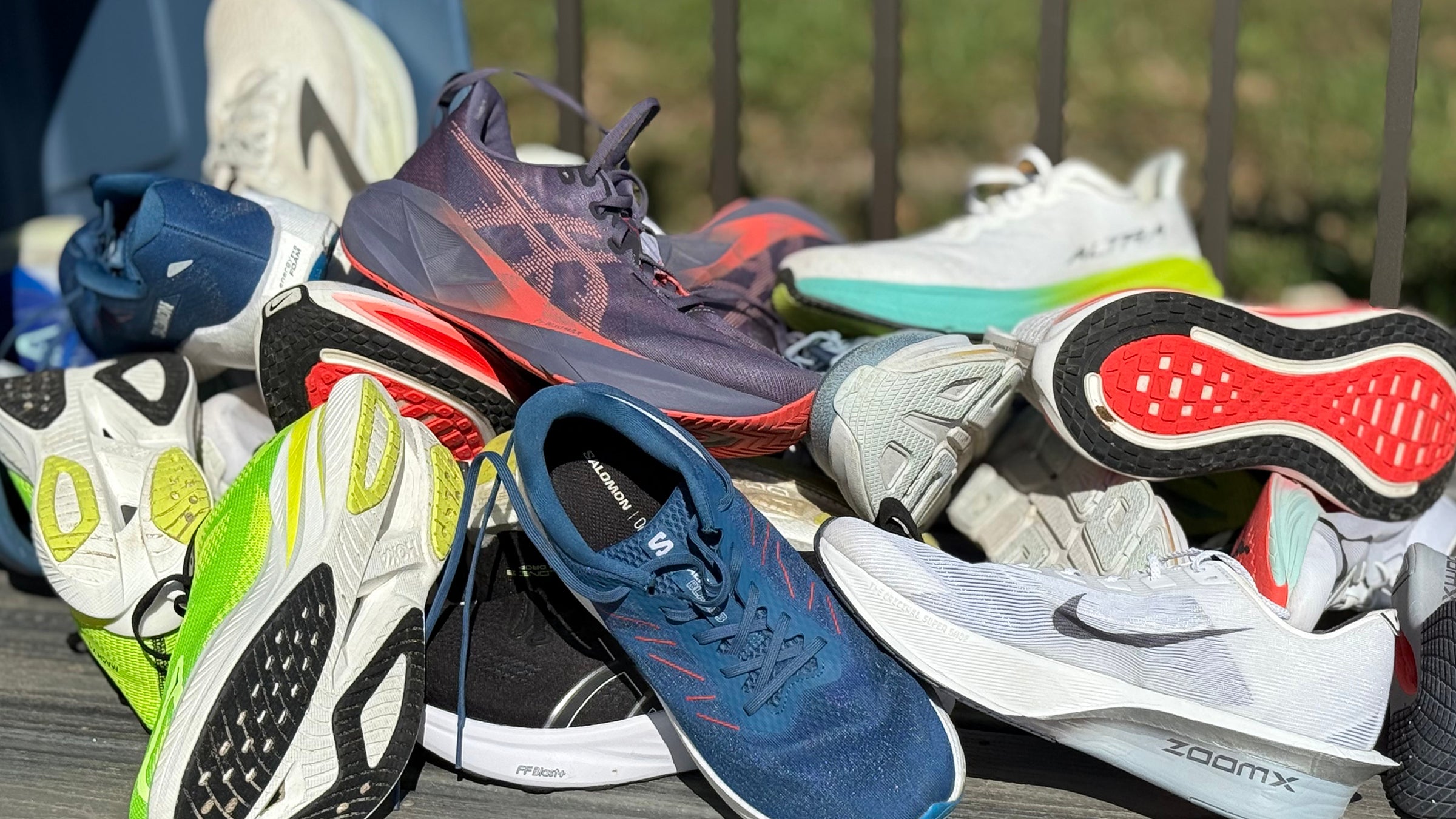
(Photo: 101 Degrees West)
Table of Contents
Picking the best road running shoe isn’t as simple as it used to be. As shoe technology has advanced, so have the options. With lighter, bouncier midsoles, comfort-focused uppers, bold new geometries, and embedded plates that boost efficiency and stability, there’s now a shoe for every type of run, making it harder than ever to know which one is right for you.
To help you choose the right running shoe for you, we continually test every new release with a diverse team of more than 20 runners, spanning a wide range of abilities and experience levels. Whether you’re a beginner learning to love running or a veteran chasing a new marathon PR, our road running shoe guide is here to help you find the perfect fit.
Updated October 2025: We’ve selected new models in eight out of 16 categories and updated prices and availability for all the best road running shoes in the guide.
Best Road Running Shoes: At a Glance
Training Shoes
- Best All-Around: Asics Novablast 5 ($150)
- Best Value: Brooks Launch 11 ($120)
- Best Cushioned Trainer: Nike Vomero Plus ($180)
- Best Distance Trainer: Brooks Glycerin Max ($200)
- Best Lightweight Trainer: Asics Megablast ($225)
- Best Super Trainer: Hoka Mach X 3 ($190)
- Most Versatile: Salomon Aero Blaze 3 ($140)
- Best for Recovery Runs: Hoka Bondi 9 ($175)
- Best Natural Ride: Topo Athletic Cyclone 3 ($155)
- Runner-Up Best Natural Ride: Altra Experience Flow 2 ($140)
Stability Shoes
- Best All-Around: Asics GEL-Kayano 32 ($165)
- Best Plush Stability: Puma ForeverRun Nitro 2 ($150)
Racing Shoes
- Best Marathon Racer: Nike Alphafly 3 ($285)
- Runner-Up Best Marathon Racer: Asics Metaspeed Sky Tokyo ($270)
- Best For Shorter Road Races: PUMA Fast-R Nitro Elite 3 ($300)
- Runner-Up Best For Shorter Road Races: Nike Vaporfly 4 ($270)
Best Training Shoes
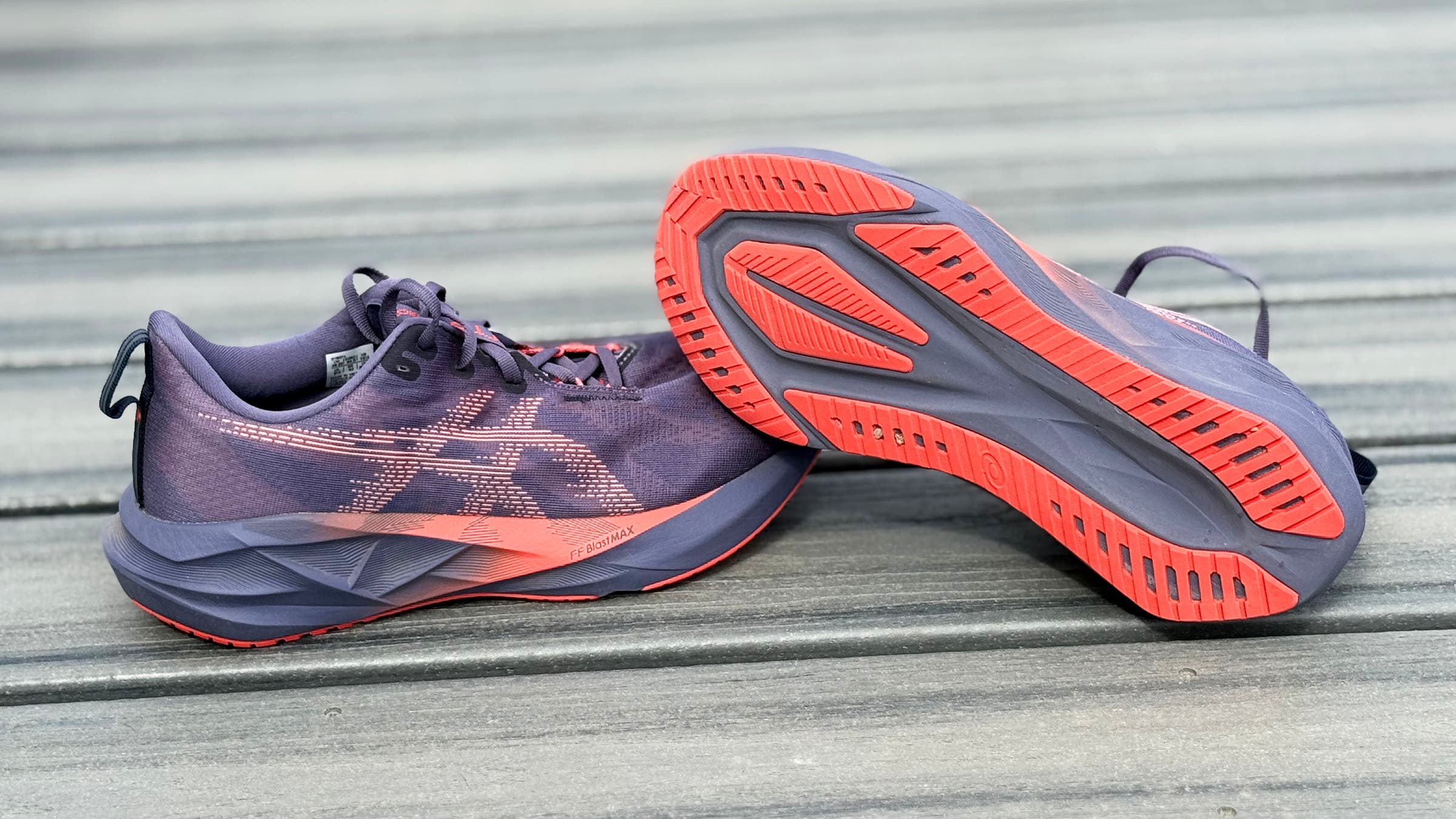
Best All-Around
Asics Novablast 5
Weight: 9.0 oz (men), 7.9 oz (women)
Stack Height: 41.5–33.5 mm (men’s); 40.5–32.5 mm (women’s)
Drop: 8 mm
Sizing: 6-13, 14, 15 (men’s), 5-12 (women’s)
Pros and Cons
+ Great weight-to-cushioning ratio
+ Smooth ride
– Poor outsole grip in slick conditions
Versatile, cushioned, and responsive, few shoes check as many boxes as the ASICS Novablast 5. Underfoot, ASICS upgraded the midsole to FF Blast Max, a polyolefin-based compound that’s a touch softer and bouncier than its predecessor. Testers praised it for its “plush experience” and “lively and energetic feel underfoot.” The shoe delivers a buttery smooth ride with a noticeable poppy feeling most everyday trainers lack. Despite the thick stack of foam underfoot, the Novablast 5 remains surprisingly nimble for an everyday trainer. While it’s not our first choice for dedicated speedwork, it handles uptempo efforts better than any other daily trainer we tested. The ride is also surprisingly stable thanks to the wide base and the responsiveness of the foam, which saves it from feeling squishy.
The fit, which is true to size, remains largely unchanged from the Novablast 4. Testers appreciated the new stitch-free engineered jacquard mesh upper, noting it felt a touch softer, improving overall comfort. Straight out of the box, the Novablast 5 felt run-ready with no break-in required.
One area that could be improved is the outsole. In an effort to keep the weight down, ASICS skimped on the rubber. This didn’t affect traction on dry surfaces, but one tester noted that he lacked confidence in the shoe during cold and wet runs. “It’s not slick, but it doesn’t grip,” he said.
We rarely suggest one shoe that would work for every runner, but the ASICS Novablast 5 is a standout that just about anyone would appreciate for almost any type of run.
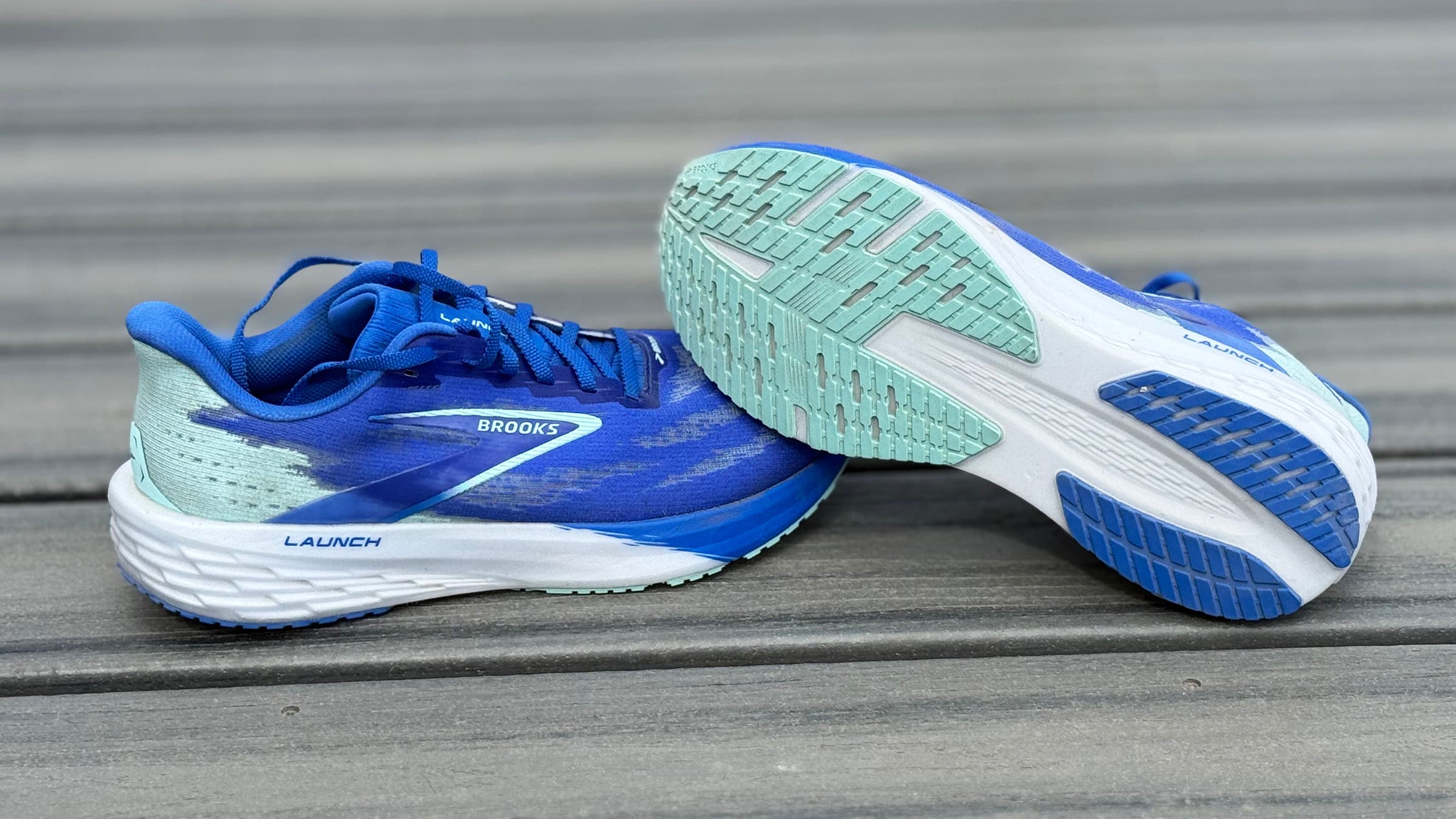
Best Value Road Running Shoe
Brooks Launch 11
Weight: 7.7 oz (men), 7.1 oz (women)
Stack height: 35.5–27.5 mm
Drop: 8 mm
Sizing: 7-15 (men’s), 5-12 (women’s)
Pros and Cons
+ A lot of bang for the buck
+ Foot-following fit and ride
+ Versatile
– Narrow for some
It is not easy to find a good running shoe for less than 125 bucks these days, but the Brooks Launch 11 is an exception. The Launch 11 may not offer massive cushion or a carbon or nylon plate, but we kind of love that about it. Instead of the trampoline-like ride of so many other shoes on the market right now, the Launch 11 provides a classic, almost old-school vibe by allowing groundfeel while still offering a little bouncy rebound. Paired with an upper that conforms around and moves with your feet, plus looks great, we think this shoe gives a range of runners great bang for their buck.
With this update to the Launch, Brooks added 1.5 millimeters more lightweight, responsive cushioning (Brooks nitrogen-infused DNA Flash foam) under the heel and 2.5 millimeters more under the forefoot, with an insert of even lighter and springier DNA Flash 2. This gives the Launch 11 a higher stack height but a lower heel-toe offset (eight millimeters instead of 10) than the Launch 10. We found this update super comfortable and more than capable for everything from daily miles at a cruisy pace to shorter, faster efforts, and even allowed us to dance nimbly over tame trails. One tester noted that this shoe feels “light and springy and propels you forward,” while another called it “downright snappy.” Another tester gave the $120 Launch 11 a score of 10 out of 10, raving that it has “one of the best sneaker fits so far” for her narrow foot, with “all the bells and whistles needed.” Some other testers, however, found the fit too narrow.
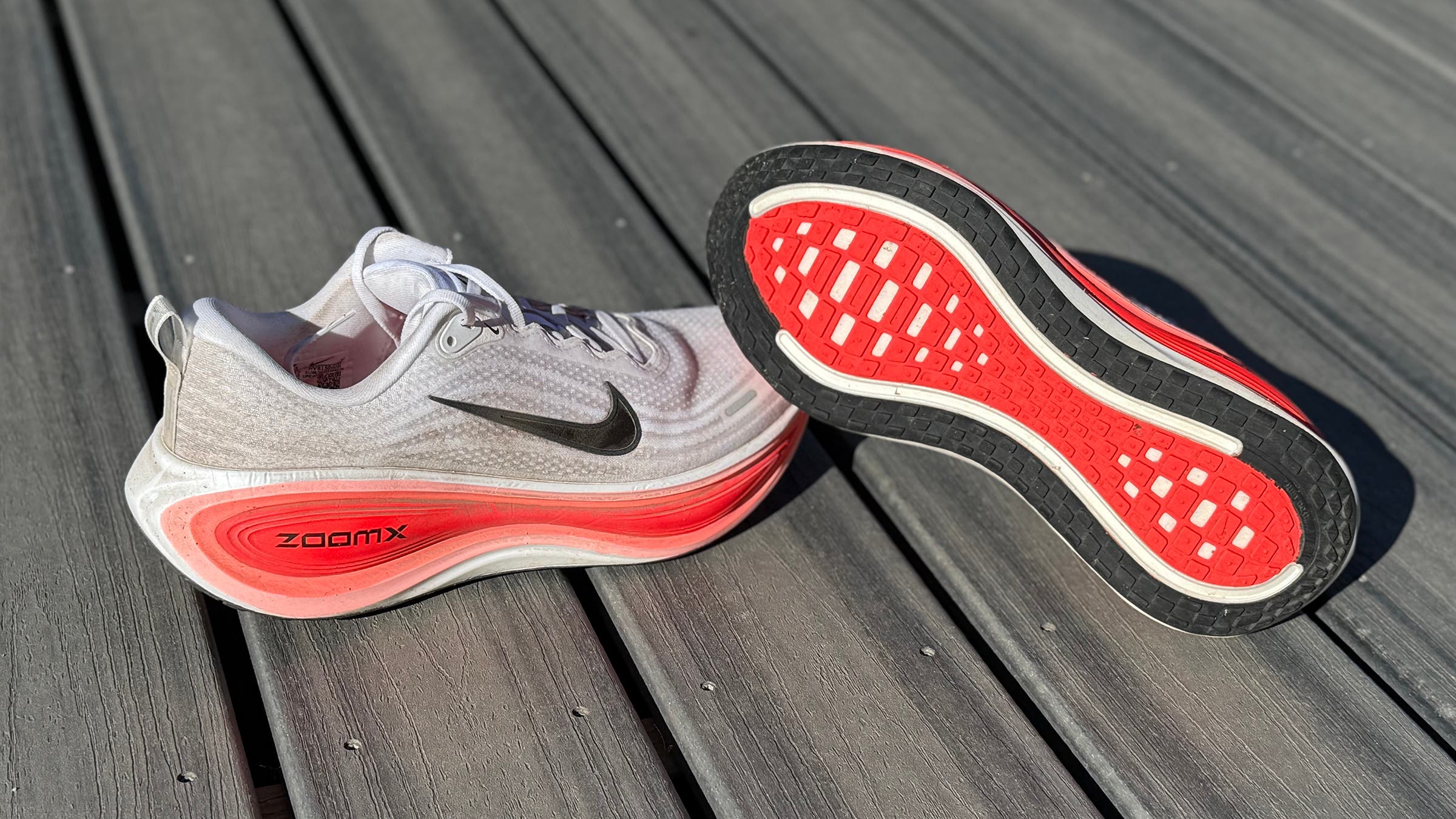
Best Cushioned Trainer
Nike Vomero Plus
Weight: 10.3 oz (men), 8.5 oz (women)
Stack Height: 45-35 mm
Drop: 10 mm
Sizing: 6-13, 14, 15 (men’s), 5-12 (women’s)
Pros and Cons
+ Highly cushioned, yet responsive
+ Well-padded, über-comfortable collar and tongue
– Loud slapping sound during running
To meet the growing demand for more cushioning among road runners, Nike has expanded the perennially popular Vomero franchise into three versions: the Vomero 18, Vomero Plus, and Vomero Premium, with each new level packing in a little more cushioning than the last. Our testers found the standout of the three, in terms of performance, to be the all-new, middle-level Vomero Plus. “In a market that has gone too soft, there is a place for a springy max cushioned shoe, and the Vomero Plus hits that mark,” said one tester.
With a full midsole of TPE-based ZoomX foam underfoot, testers reported that the Vomero Plus is lighter, bouncier, and softer road running shoe than the base model Vomero 18. A thick layer (45 millimeters!) of foam underfoot assures a plush, pillow-like ride, but the shoe doesn’t weigh you down or wallow in mush like some high stack height shoes. There’s a touch of responsiveness hiding within the max-cushioned midsole. While it’s not a fast shoe or racer, it doesn’t plod either. The foam feels lively underfoot from the first contact, and quickly transitions the foot to a smooth toe-off, thanks to a rockered and slightly flexible forefoot.
The engineered mesh upper prioritizes comfort, starting with the heavily padded tongue and overstuffed heel collar, which hug the foot in plushness from the initial step-in to the last mile. One tester credited that secure hold, combined with the width of the sole and the responsive rebound of the foam, for the shoe’s surprising stability.
The only quirk? Like other ZoomX running shoes, it’s loud, with a distinct slap every time your foot hits the ground—but that was only a minor annoyance. When pitted against the best max-cushioned trainers available, the Vomero Plus takes the edge in comfort, ride, and versatility. “It is the one shoe in the test that is in heavy rotation for me, so much so that it was the only trainer I brought on vacation,” noted one tester.
Read our full Nike Vomero Plus Review.
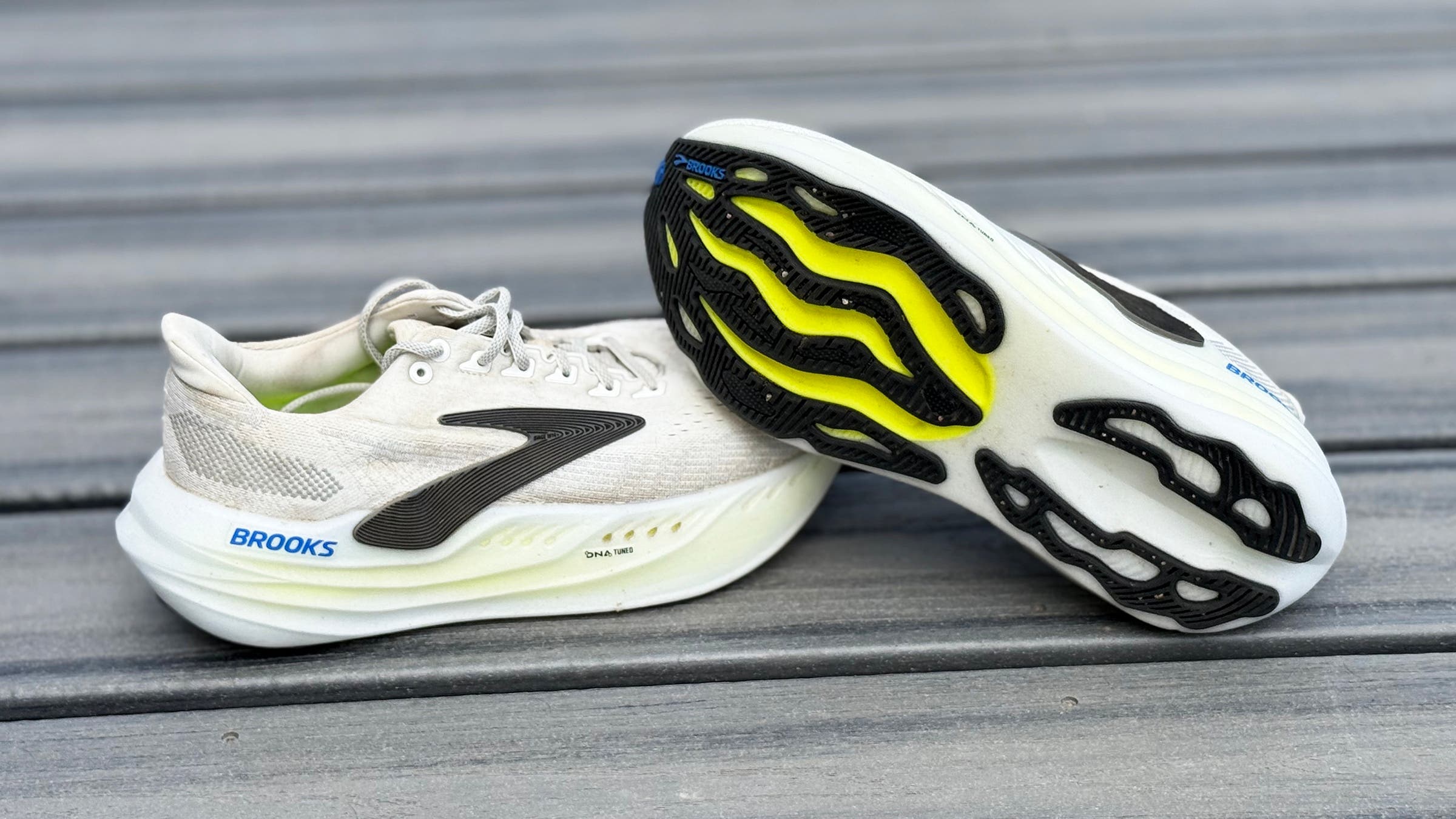
Best Distance Trainer
Brooks Glycerin Max
Weight: 10.5 oz (men), 9.5 oz (women)
Stack Height: 45–39 mm
Drop: 6 mm
Sizing: 7-13, 14, 15 (men’s), 5-12 (women’s)
Pros and Cons
+ Tuned midsole is both soft and responsive
+ Wide platform keeps tall midsole stable
– Feels somewhat bulky
The Brooks Glycerin has long been Brooks’ premium highly cushioned everyday trainer. However, with stack heights increasing across the industry, its 38mm/28mm profile no longer stands out as a true max-cushioned option for long-distance running. Enter the Glycerin Max, which is Brooks’ highest-stacked shoe to date but manages to not feel overly tall.
Brooks’ new DNA Tuned midsole starts with its familiar nitrogen-infused EVA-based compound, but instead of being a consistent density throughout, the foam has different-sized cell structures in different locations, making it softer on the outside of the heel and firmer and more responsive on the inside of the heel and throughout the forefoot. “The result is a high-cushion shoe that I found doesn’t wallow and allows the foot to engage as it rolls through the stride, making it a shoe that I, usually a max-shoe hater, wanted to wear more,” noted one tester.
Raised sidewalls and a noticeably wide base aid in creating a stable stance for such a tall shoe. To enhance a smooth roll from an otherwise inflexible sole, a rockered forefoot encourages a natural forward transition, helping maintain momentum with each stride. A rather simple engineered mesh upper, consistent with other Brooks models, provides a true-to-size fit that complements the shoe’s plush underfoot feel. All in all, the Glycerin Max coddled our feet while rolling smoothly through the miles, making us want to keep going no matter how far from home we wandered.
Read our full Glycerin Max review.
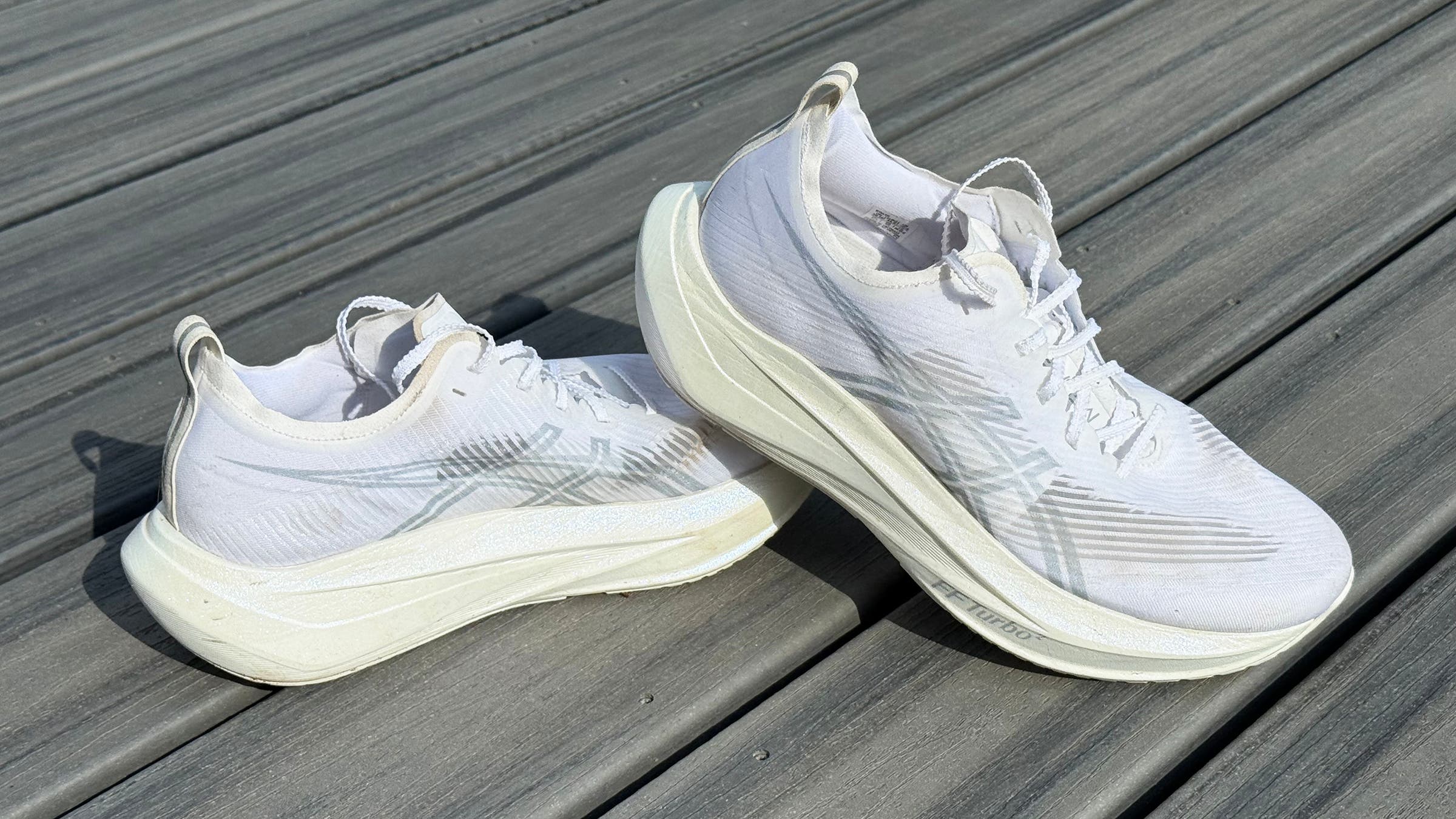
Best Lightweight Trainer
ASICS Megablast
Weight: 8.1 oz (men’s size 9; women’s 10.5)
Stack Height: 45-37 mm
Drop: 8 mm
Sizing: 3.5-13, 14 (men’s), 5-14.5, 15.5 (women’s)
Pros and Cons
+ Insanely lightweight for the amount of cushioning
+ Performs well across all paces
– Thin upper isn’t as comfortable as other everyday trainers
Among all the categories of road running shoes, the lightweight trainer is arguably the most versatile: durable and comfortable enough for daily mileage, yet responsive and agile enough for uptempo efforts and even race-day duty. The Asics Megablast exemplifies this balance in a surprising package, earning its place as the best road running shoes for versatility. While lightweight trainers are traditionally lower profile, the Megablast measures 45 millimeters under the heel. But weighing in at just 8.1 oz (men’s size 9 / women’s 10.5), it offers an unmatched weight-to-cushioning ratio.
And it doesn’t lack in pep or fun factor, either: Its full-length, single-density superfoam midsole delivers a slightly firm, highly reactive ride. Asics touts its FF Turbo Squared, A-TPU-based foam as its most energetic midsole compound yet. One tester echoed that claim, calling it “the lightest, bounciest, and most comfortable cushioning I have ever run in.” The shoe seems to push the pace on its own, with the faster tempo requiring less effort than usual.
The upper is a thin, engineered, woven mesh: streamlined, secure, breathable, and clearly tuned more for performance than plush, step-in comfort. Testers didn’t mind the minimal padding, but runners who prefer a softer, thicker upper may find it barebones.
Regardless of pace or footstrike, the ride feels instinctively dialed in. “If the goal was to build the Swiss Army knife of shoes, ASICS nailed it,” said one tester. The Megablast is lighter, faster, and more energetic than any similarly stacked road running shoe, redefining what a lightweight trainer can be.
Read our full Asics Megablast review.
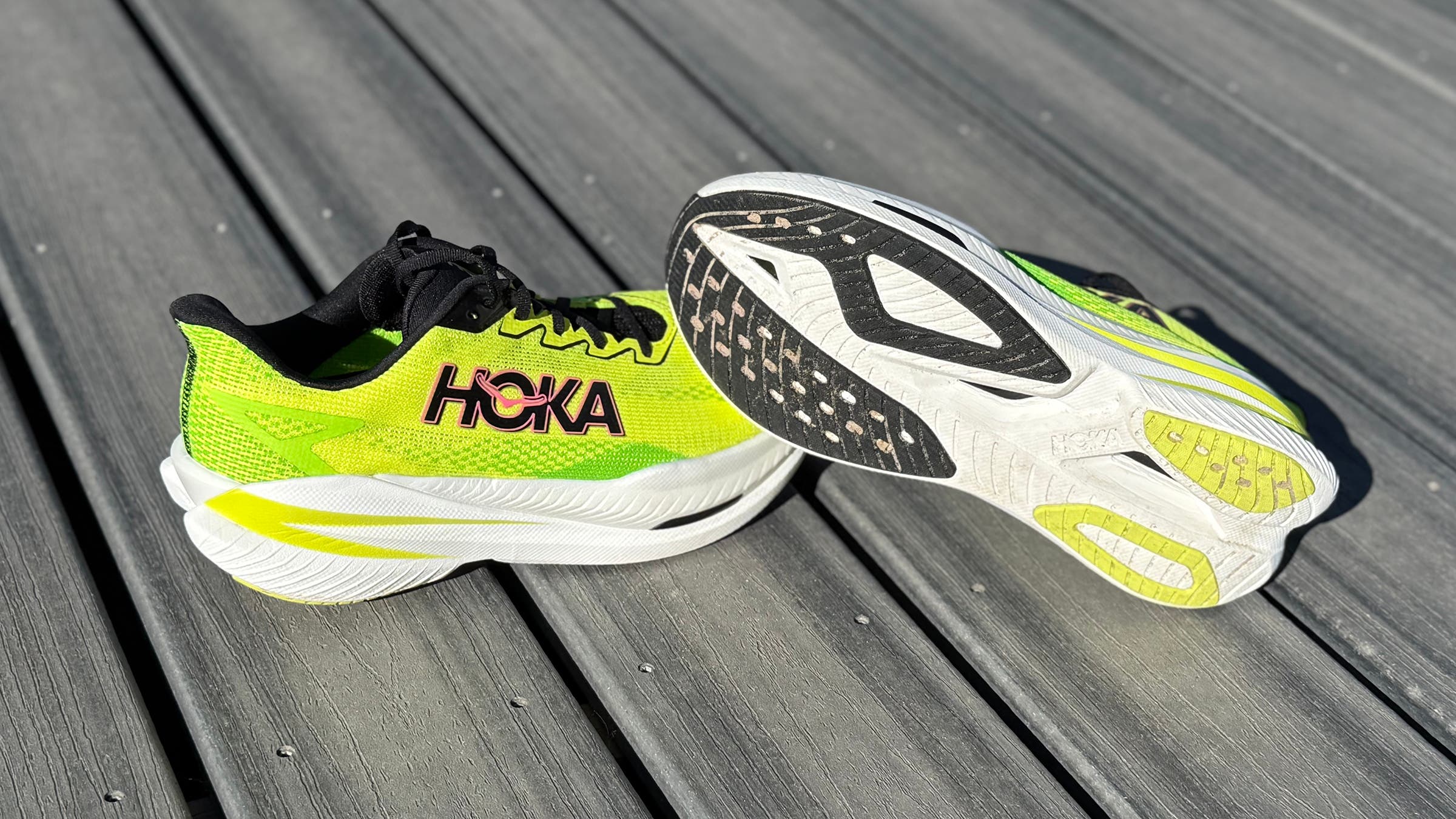
Best Super Trainer
Hoka Mach X3
Weight: 10.2 oz (men’s), 8.6 oz (women’s)
Stack Height: 44-39 mm (men’s), 42-38 mm (women’s)
Drop: 5 mm (men’s), 4 mm (women’s)
Sizing: 7-14 (men’s), 5-11 (women’s)
Pros and Cons
+ Versatile trainer/racer
+ Pebax plate and PEBA cushioning provide lively ride
– Might feel too high for some
With soft and lively PEBA foam on top delivering cushioning, a springy, flexible Pebax plate adding pop, and firmer EVA foam beneath the plate providing a stable platform, the Mach X 3 running shoe has a lot going on in its very-fat midsole. The combo works. All that cush kept us from feeling beat up after tempo runs, and the winged plate seems to enable a smooth, balanced feeling of propulsion. We loved this training shoe for making the miles feel easier and go by quicker.
The swallow tail shape of the foam under the heel, combined with the shoe’s overall mild rockered silhouette, made for a notably fluid stride, especially for heelstrikers. And while the stack height is mega, the Mach X 3 didn’t feel clunky or overbuilt. “These shoes make me feel fast even when my body is tired,” said a tester. ”My splits are faster with less effort.”
The warp knit upper with minimal overlays and seams provided a comfortable, secure fit that felt great at step-in and remained that way through long runs, while the lightly padded tongue kept the laces from causing any pressure against the top of our feet. The heel collar has been effectively redesigned from the Mach X 2; we found it comfortable and secure.
One knock: rocks can become lodged in the gaps in the outsole, making it not ideal for taking these on gravel paths or light trails. Still, the Mach X 3 shines for those who like to mix up the pace. As one tester put it, “This is a great daily runner, speed work out shoe, and even racer for road warriors.”
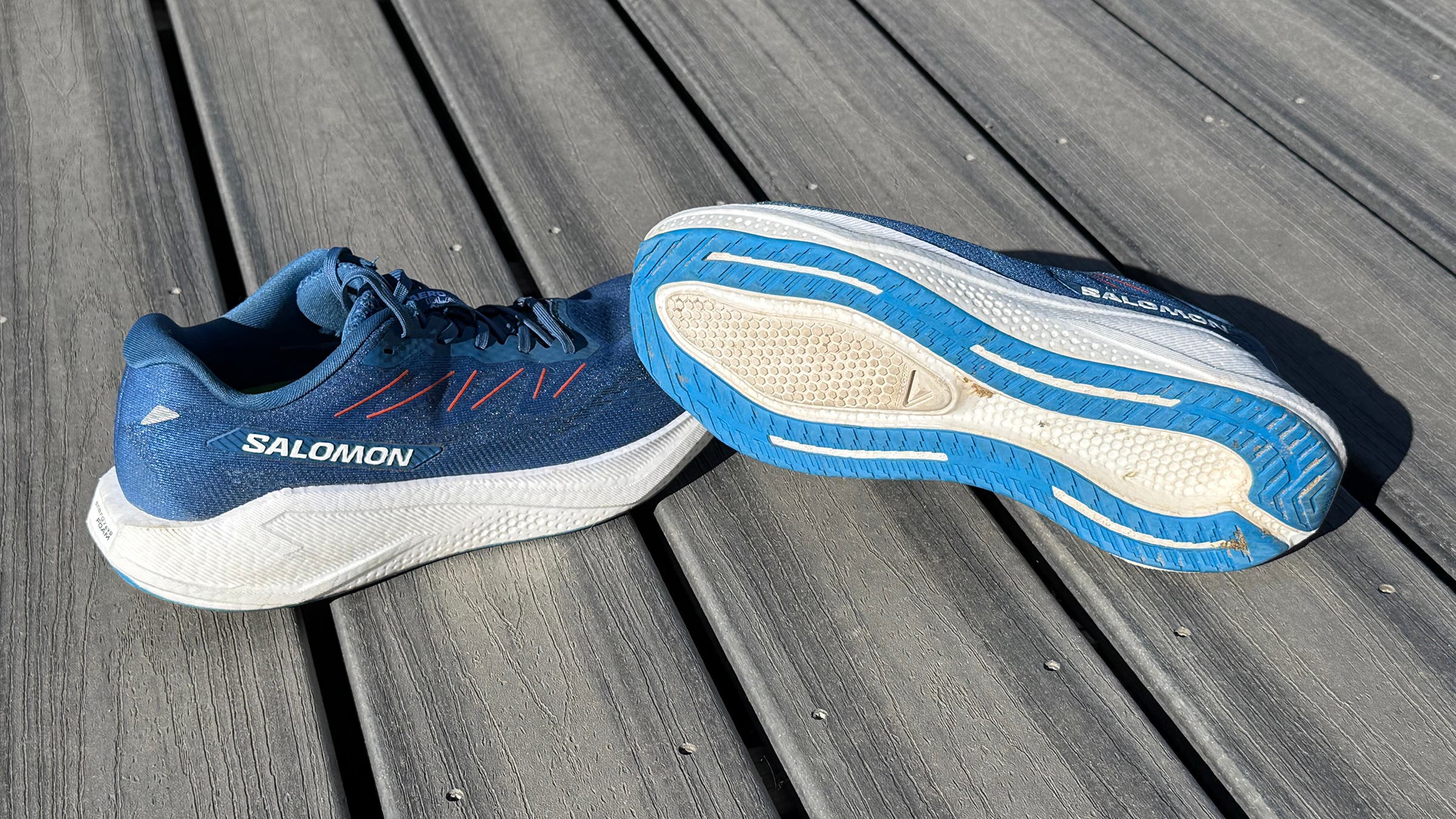
Most Versatile
Salomon Aero Blaze 3
Weight: 8.1 oz (men’s), 6.8 oz (women’s)
Stack Height: 35-27 mm
Drop: 8 mm
Sizing: 7-13, 14 (men’s), 5-11 (women’s)
Pros and Cons
+ Lightweight
+ Versatile for a range of paces
+ Competitive price for a high-tech, high-performance shoe
– Slippery laces require double-knotting
The star of the Salomon Aero Blaze 3 is its extremely lightweight, responsive midsole. It’s a proprietary compound made out of tiny beads of eTPU that expand when heated under pressure to form a cushy (but not squishy) and springy material.
At just over 8 ounces for men, and just under 7 ounces for women, the Aero Blaze 3 running shoe feels energetic and fast. “It really makes you want to pick up the pace,” said one tester. Another noted that the gentle toe rocker rolled his stride forward smoothly and had enough flex to engage his toes and encourage an efficient stride. The engineered mesh upper proved breathable in hot temps and secured our feet from heel through midfoot with a relaxed fit from the ball of the foot forward (which made for happy toes).
Salomon’s Contagrip rubber runs around the perimeter of the outsole, while a cutout under the heel seemed to help with rebound upon heel strike (and helps the shoe maintain its feather weight.) We did find the forefoot to feel a tad firm on long runs, but love how this road running shoe can go from a track workout to a tempo run to daily miles, even on gravel paths. It’s comfortable overall and earned high marks from a range of testers. “I feel supported and energized running in the Aero Blaze 3 at any pace,” said one.
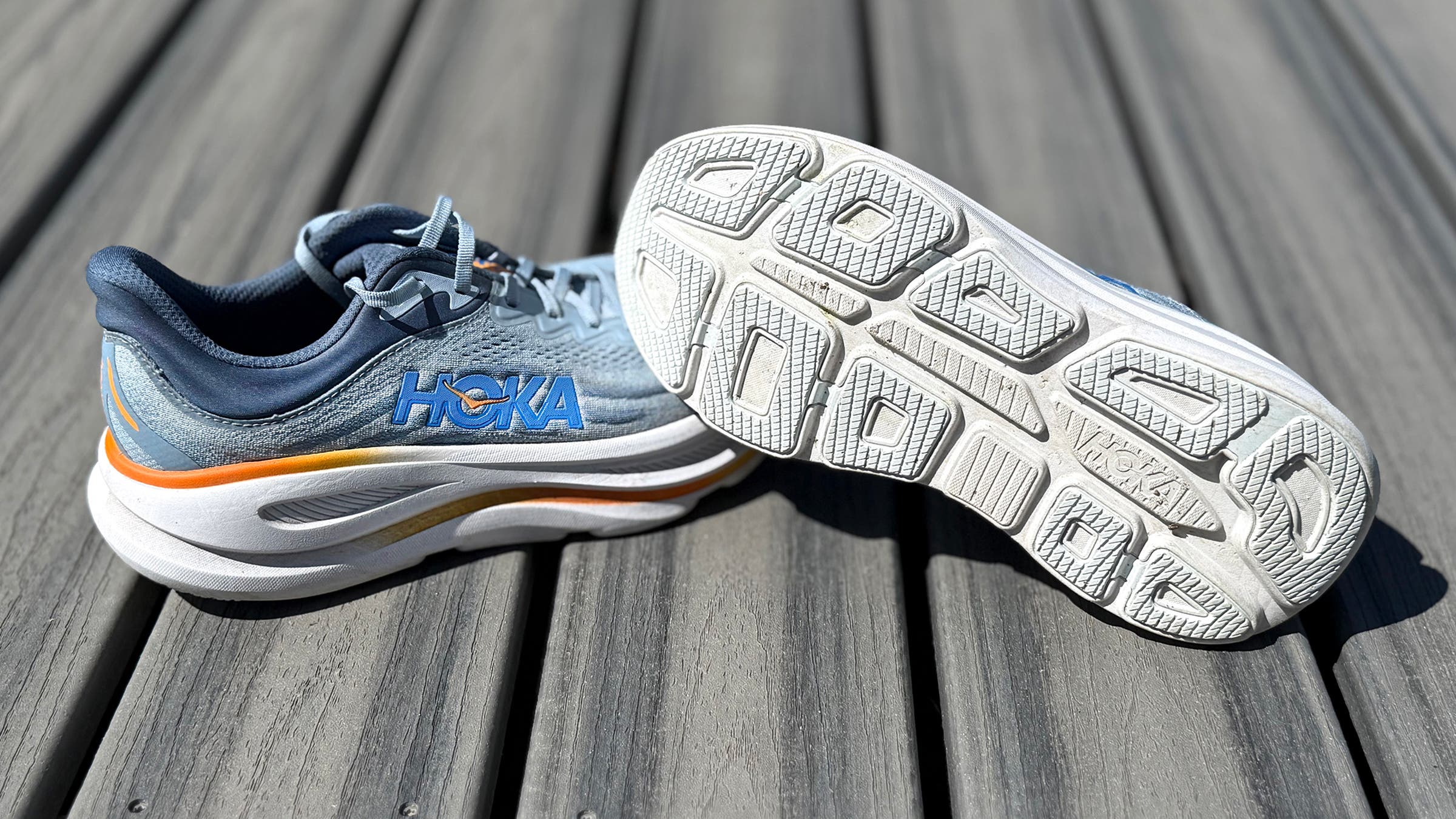
Best For Recovery Runs
Hoka Bondi 9
Weight: 10.5 oz (men), 9.3 oz (women)
Stack Height: 43-38 mm (men), 42-37 mm (women)
Drop: 5 mm
Sizing: 7-16 (men’s), 4-12 (women’s); D, 2E, 4E widths
Pros and Cons
+ Upgraded, livelier midsole
+ Plush upper
– Stiff sole
When your legs are still aching from yesterday’s run, few things feel better than slipping into a pair of thick-soled running shoes with a plush, cushioned upper—something just like the Hoka Bondi 9. For this version, Hoka completely overhauled the midsole, adding two millimeters of stack height and replacing the standard EVA foam found in the Bondi 8 with a new supercritical (gas-infused) EVA compound. The result? A softer, more responsive ride.
We were pleasantly surprised to find the Bondi 9 had a speedy streak that we would not expect from such a thick-soled shoe. One longtime Bondi tester described the updated version as more plush and squishy, with a sole that feels noticeably less stiff than the previous version. Another noted the new foam felt livelier and springier. While it’s still not a shoe we’d pull for speed sessions, it made recovery runs feel a little peppier.
Hoka incorporates strategically placed flex grooves, carved into the outsole and bottom of the midsole, to promote smooth transitions and enhance flexibility throughout the gait cycle. That said, compared to most running shoes, we still found the Bondi 9 to have one of the least flexible soles. But Hoka’s signature rocker shape, which allows the foot to roll forward without bending, compensates for this, and the shoe delivered a smoothly flowing ride from heel-strike to toe-off.
The engineered mesh upper is generously padded around the heel collar and tongue, providing a secure and comfortable wrap around the foot. One tester praised the extra cushioning, noting that it made the shoe fit better. On that note, all agreed that the Bondi 9 runs true to size.
If you’re looking for the classic plush and protected Hoka ride, the Bondi 9 delivers. “It’s got all the right bells and whistles of a true Hoka,” said one tester.
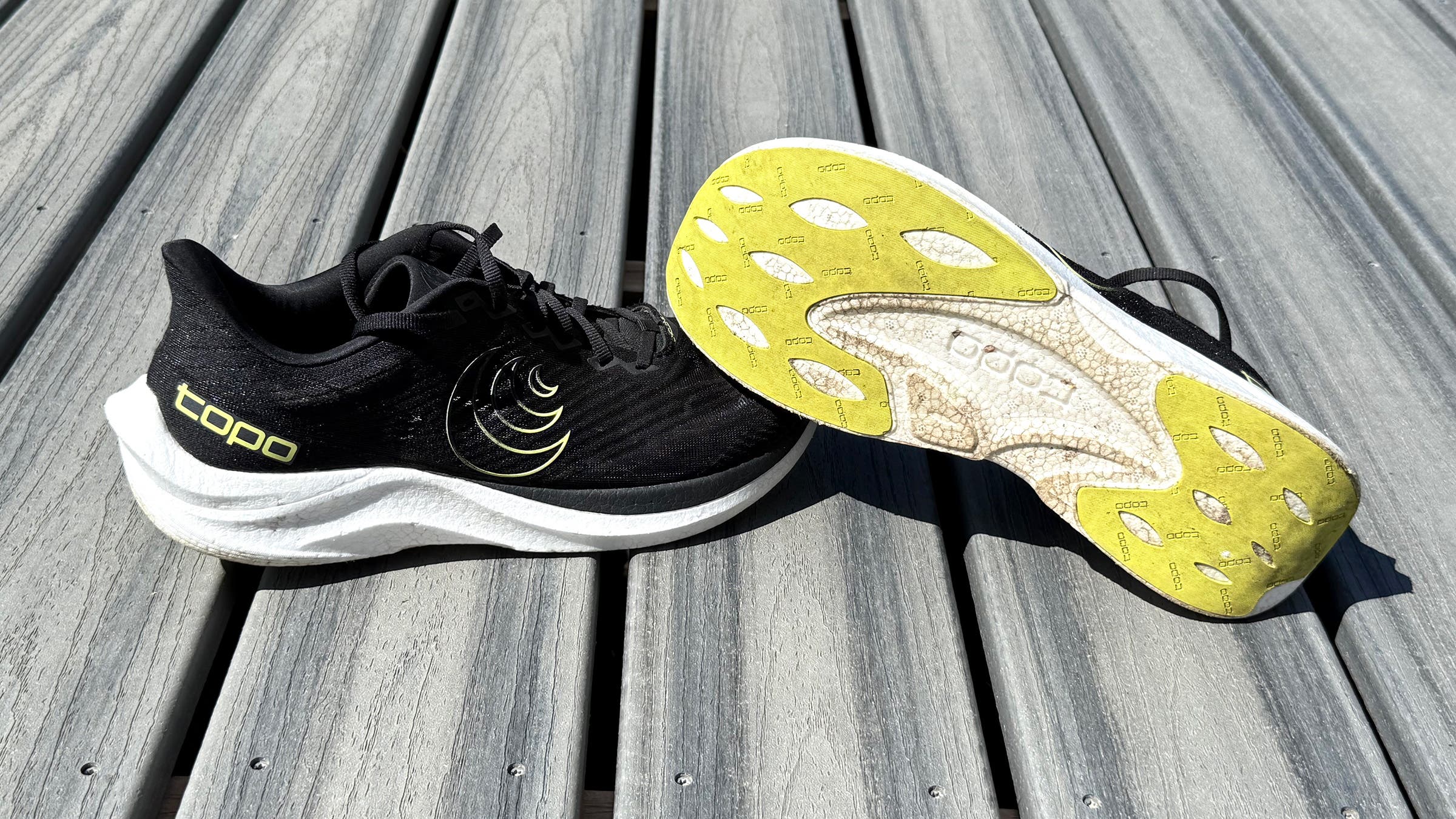
Best Natural Ride
Topo Athletic Cyclone 3
Weight: 6.9 oz (men’s), 5.5 oz (women’s)
Stack height: 28–23 mm
Drop: 5 mm
Sizing: 8-13 (men’s), 6-11 (wome’ns)
Pros and Cons
+ Extremely lightweight
+ Comfortable toe space with secure foothold
+ Excellent ground feel combined with bouncy cushioning
– Limited to short runs for most
Topo Athletic shoes are known for their roomy toe box, which provides ample wiggle room and allows for natural foot movement, while also offering a secure midfoot and heel hold. The Cyclone 3 lives up to that reputation. We felt, in fact, that the foot hold and comfort of the Cyclone 2 was improved upon here. And in an era where the vast majority of shoes boast massive amounts of midsole foam and rigid propulsion plates, the Cyclone 3 unapologetically keeps things simple with a thin, flexible layer of premium Pebax foam.
This shoe may have one of the lowest stack heights available on the market (short of minimalist models), but the Pebax midsole still provides springy cushioning that one tester said makes you want to run faster: “When you put it on you feel like you can take off quicker than expected. It’s an easy-going ride.” Another noted, “As the foam compresses, I feel a connection with the ground without being harsh, and when it bounces back, it seems to enhance the power of my push-off.”
We credit the Cyclone 3’s easy forward roll to its incredibly light weight, rockered geometry, great flexibility, and midsole pop. “This reminds me of an old-school, lightweight, flexible shoe for speed and racing,” said a tester.
We found the airy upper ideal for summer running, whether in the hot and dry climate of Colorado, thick humidity of Virginia, or tropical vibes of Hawaii. And because of its feather weight, flexibility, and versatility, the Cyclone 3 is a great choice for traveling: it packs easily and is equally adept whether running on the soft surfaces of a beach or a concrete bike trail.
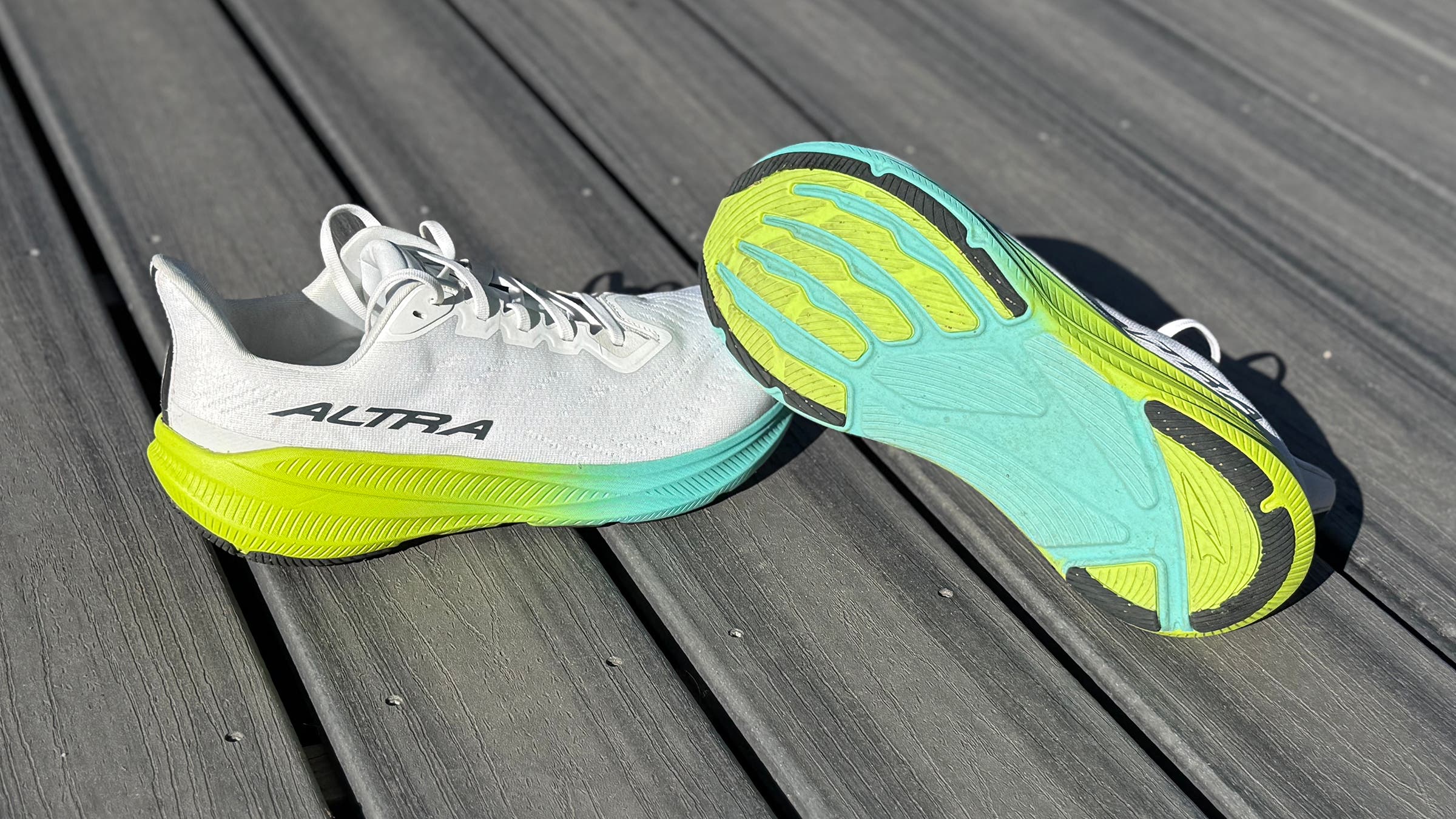
Runner-Up Best Natural Ride
Altra Experience Flow 2
Weight: 8.2 oz (men’s), 7.1 oz (women’s)
Stack Height: 32-28 mm (men’s), 30-26 mm (women’s)
Drop: 4 mm
Sizing: 7-15 (men’s), 5.5-12 (women’s)
Pros and Cons
+ Natural foot shape
+ Soft and springy ride
+ 4mm drop that works for a range of runners
– Slightly too soft under the heel
Like the original Altra Experience Flow (and other models in Altra’s Experience line), the Experience Flow 2 brings Altra’s natural foot shape—notably, a wide toe box—to the masses by offering a moderate, four-millimeter drop instead of the brand’s signature zero-drop platform. New to the second version is a softer, springier midsole foam that elevates comfort and makes the Experience Flow 2 road running shoe feel less minimal than its predecessor.
The midsole is a new version of Altra’s EGO foam, now blended with 35 percent polyolefin elastomer, which makes it feel both softer and more responsive. “As soon as I stepped into the shoe and took off, I felt a medium-soft underfoot cush that was not so soft it prevented responsiveness and good speed pick up,” said a tester.
The fit was improved from the first Experience Flow, with a more secure hold at the heel. “It’s super-duper comfy,” said a tester. “It forms to the foot, has space in the toe box, and isn’t too snug through the midfoot while hugging the heel.”
This is a smooth-riding, neutral shoe that rolls through the stride with ease. “The beveled heel created a gentle transition onto the midsole platform on landing, and the lightly-rockered forefoot complemented the flexible sole to roll me quickly and smoothly off the toe,” said a tester.
Testers noted that with a heavy heel strike, the Experience Flow 2’s soft foam sunk under the heel and made the stride wallow a bit while transitioning up and over the thick forefoot. It still works for most runners, but encourages and rewards a tall, forward-balanced, quick, efficient stride, like all Altras do—but with less penalty while adapting. It’s one of the best road running shoes for those who want the comfort and foot-releasing activation of a wide toe box but haven’t felt like they could run in Altra shoes before.
Read our full Altra Experience Flow 2 review.
Best Stability Shoes
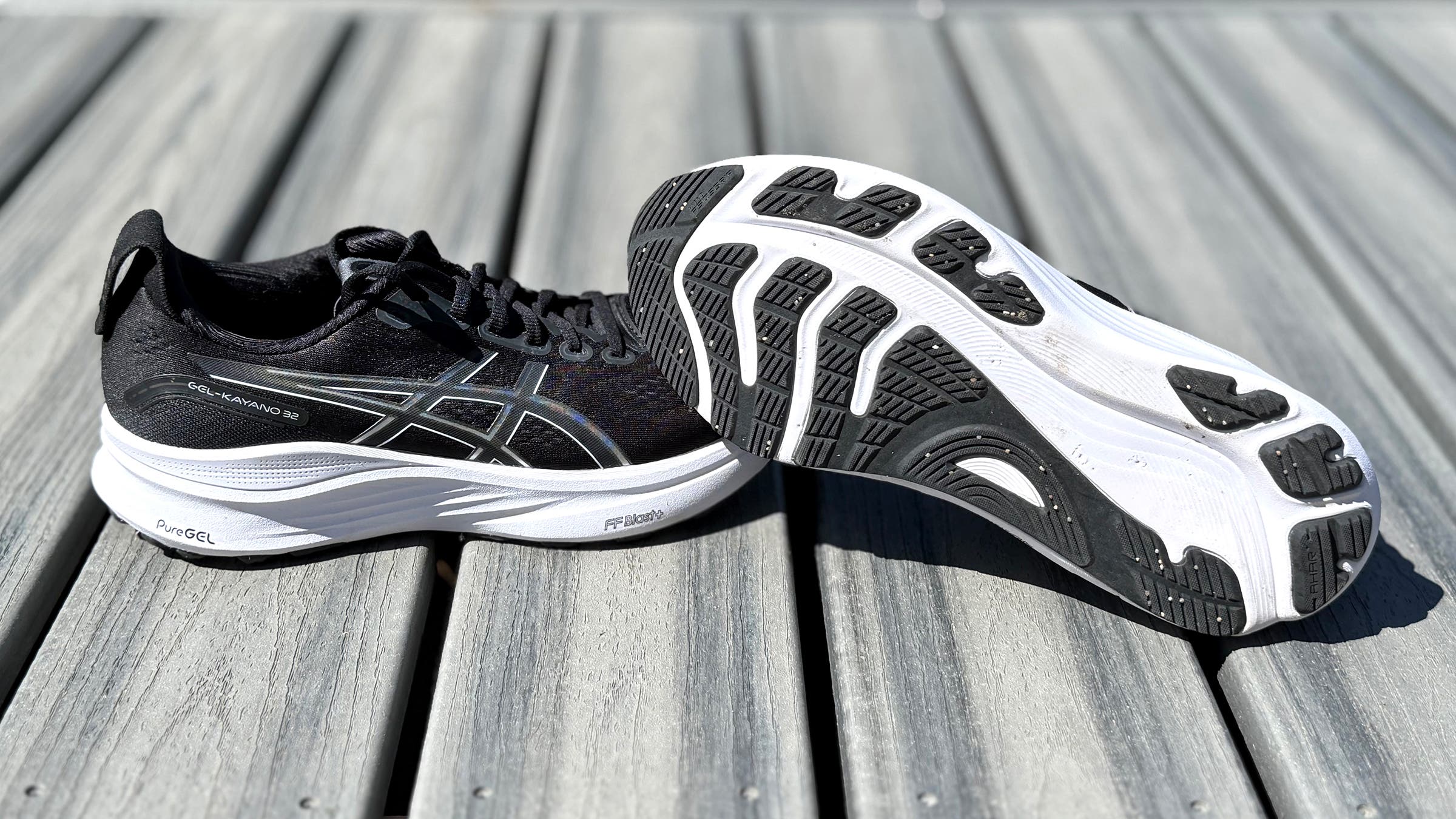
Best All-Around Stability Shoe
Asics Gel-Kayano 32
Weight: 10.6 oz (men), 9.0 oz (women)
Stack height: 40–32 mm (men’s), 39–31 mm (women’s)
Drop: 8 mm
Sizing: 6-16 (men’s), 5-13 (women’s)
Pros and Cons
+ Reliable, smooth stability
+ Plush cushioning
– On the heavier side
Two Kayanos ago, Asics ditched the traditional medial post with a more forgiving, smoother-running geometry and foam combination to achieve stability for those who need it. The Kayano 31 built on the success of the 30, and the Kayano 32 is even better. This is a plush, well-cushioned, supportive shoe that can take overpronators from mile one to 26, and through all of their long-run training miles. It’s not a lightweight, speedy shoe, but it doesn’t claim to be.
Stability comes from a wide, flared sole and a soft, bouncy insert under the arch designed to reduce how long a runner’s foot is in a pronated position. “The shoe feels supportive under the midfoot, but not firm,” said one tester. “It allows my foot to move naturally, then rebounds under the arch and provides a pleasant push-back as I roll onto my toes.” The cushioning, while feeling slightly firmer and more responsive than that in the 31, remains plush—long gone are the days of overpronators having to wear a blocky, stiff shoe.
This version is updated with two millimeters more foam under the forefoot, reducing the heel-toe drop for a more balanced stance, making the forefoot rocker more pronounced, and delivering more comfort over the long haul. Plus, it gets a better-fitting tongue. “I found the fit and feel of the shoe to be great,” said a tester. “The gusseted tongue wraps a bit nicer than in the past, and the slightly thinner material is more sock-like so there are no pressure points.”
Final verdict: The Kayano32 is protective without feeling overbearing. This tried-and-true model has evolved, and continues to impress.
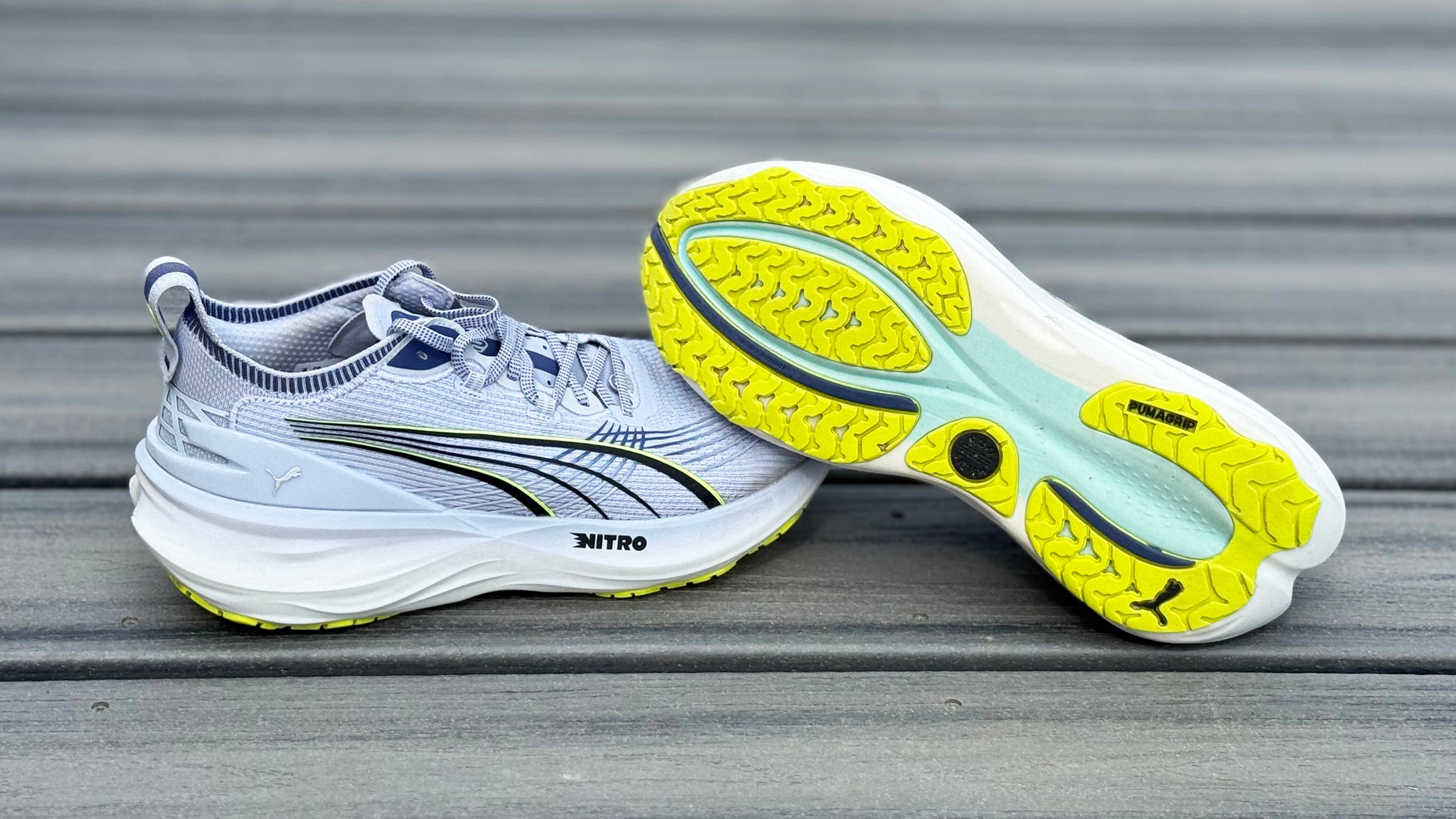
Best Plush Stability
Puma ForeverRun Nitro 2
Weight: 10.4 oz (men), 8.1 oz (women)
Stack height: 38–28 mm
Drop: 10 mm
Sizing: 7-13, 14 (men’s), 6-11 (women’s)
Pros and Cons
+ Soft and smooth
+ Stable without feeling controlling
– Toe box uncomfortable for some
The Puma ForeverRun Nitro 2’s significant stack of nitrogen-infused TPE foam underfoot and a wide forefoot silhouette make this feel like a lot of shoe. This thing is plush. But for that much cush this shoe comes in at a reasonable weight and offers a forgiving, comfortable ride.
Testers found the foam—a combination of a softer core surrounded by a firmer perimeter —to feel great underfoot, noting that the shoe ran “smooth and easy.” That’s not a description that comes easy for a stability shoe, and makes the ForeverRun Nitro 2 stand out. Complementing the underfoot cush is a premium engineered mesh upper that eliminates interior seams (aside from the partially gusseted tongue, which adds midfoot hold) to provide a welcoming step-in feel. The secure heel hold with a stabilizing external heel clip gives way to a narrow/secure-fitting midfoot, then splays out to a wide forefoot geometry that seems to add inherent stability throughout the gait cycle.
Despite the wide forefoot shape at the base, some testers craved more room on the interior, noting a feeling of crammed toes. But overall, the ForeverRun Nitro 2 is a great option for those seeking a combination of stability and cushioning in a good-looking shoe.
See our full round-up of stability shoes.
Best Racing Shoes
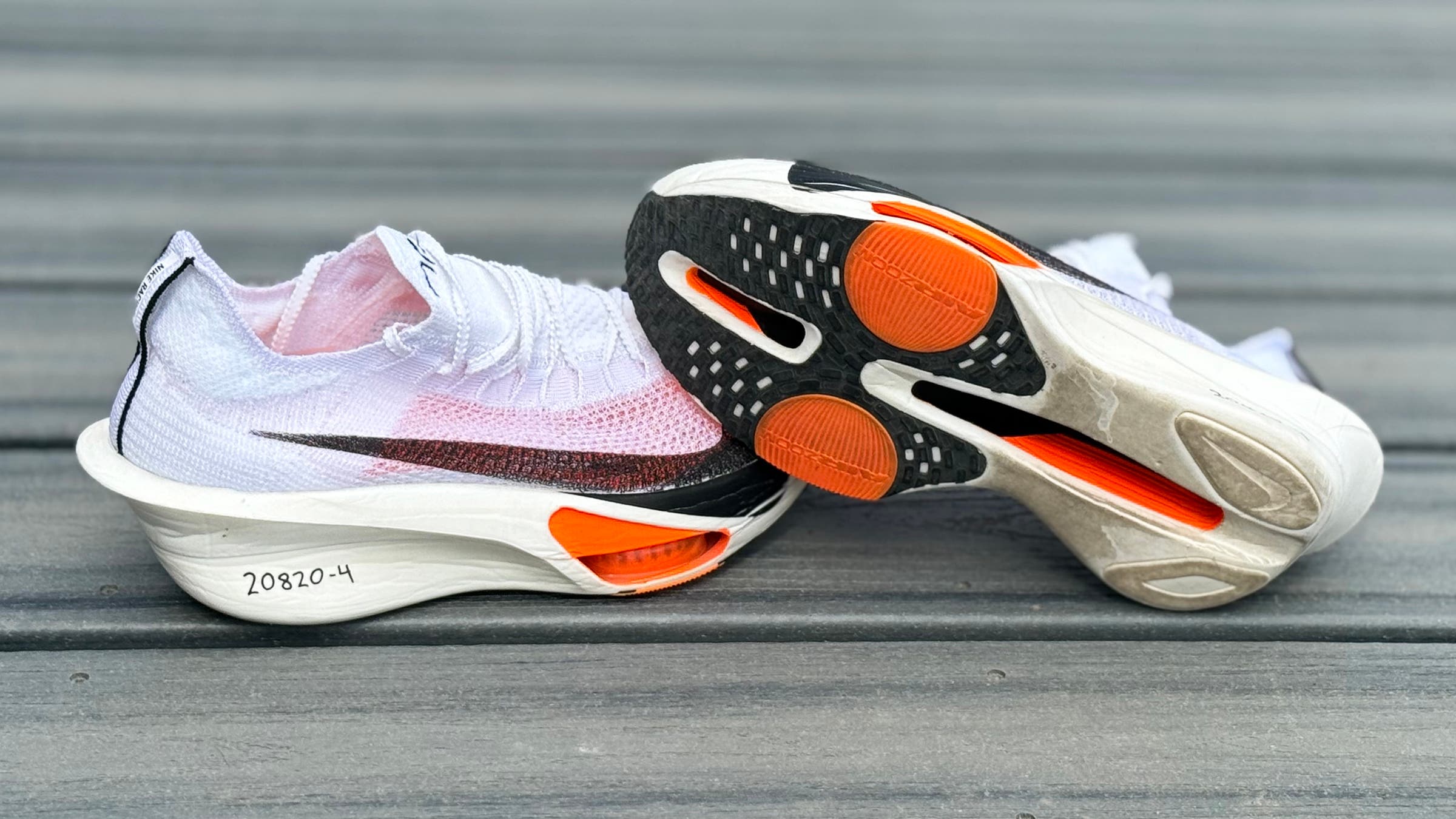
Best Marathon Racer
Nike Alphafly 3
Weight: 7.8 oz (men), 6.2 oz (women)
Stack Height: 40–32 mm
Drop: 8 mm
Sizing: 6-15 (men’s), 5-12 (women’s)
Pros and Cons
+ Bouncy, trampoline-like ride
+ Works for a wide range of runners
+ Lighter weight than previous versions of the AlphaFly
– Heel can feel unstable
– Can be hard to find in specific sizes
We’ve run in all three versions of the AlphaFly to date and think this third iteration is a great update. Subtle adjustments to the shoe’s geometry, including a wider footprint and carbon fiber plate, paired with repositioned Air Zoom units and strategically sculpted midsole, give the Alphafly 3 a distinctly different feel from its predecessor, which many found heavy and clunky compared to the original. This shoe again feels bouncy, fun, and fast.
Complementing the cush and rebound of ZoomX (Pebax) foam and Air Zoom units (pockets of compressed air and tensile threads) is a full-length carbon fiber plate that gives the shoe extra snap and adds a touch of appreciated stability that even the most efficient runners can benefit from when fatigued (marathon, anyone?). One of our more competitive testers praised the Alphafly 3 for its bouncy, energy-saving ride and says she’ll wear no other shoe for races longer than 10 miles. Another speedy tester noted, “Even running as fast as 5k pace, I found the Alphafly responded quickly, encouraging a fast turnover.” Some slower runners noted, however, that landing on the Alphafly’s sculpted heel can create a feeling of instability until the plate is engaged at the midfoot roll.
The upper of the Alphafly 3 is a lightweight, super-breathable mesh with an integrated tongue and thin, notched laces that pull tight and stay tied. Our feet were comfortable and secure without any pressure points on top of the ready-to-fly platform. We love that this shoe got lighter than its previous versions, which adds to its race-readiness.
Read our full Nike Alphafly 3 review and our showdown comparison of 16 super shoes.
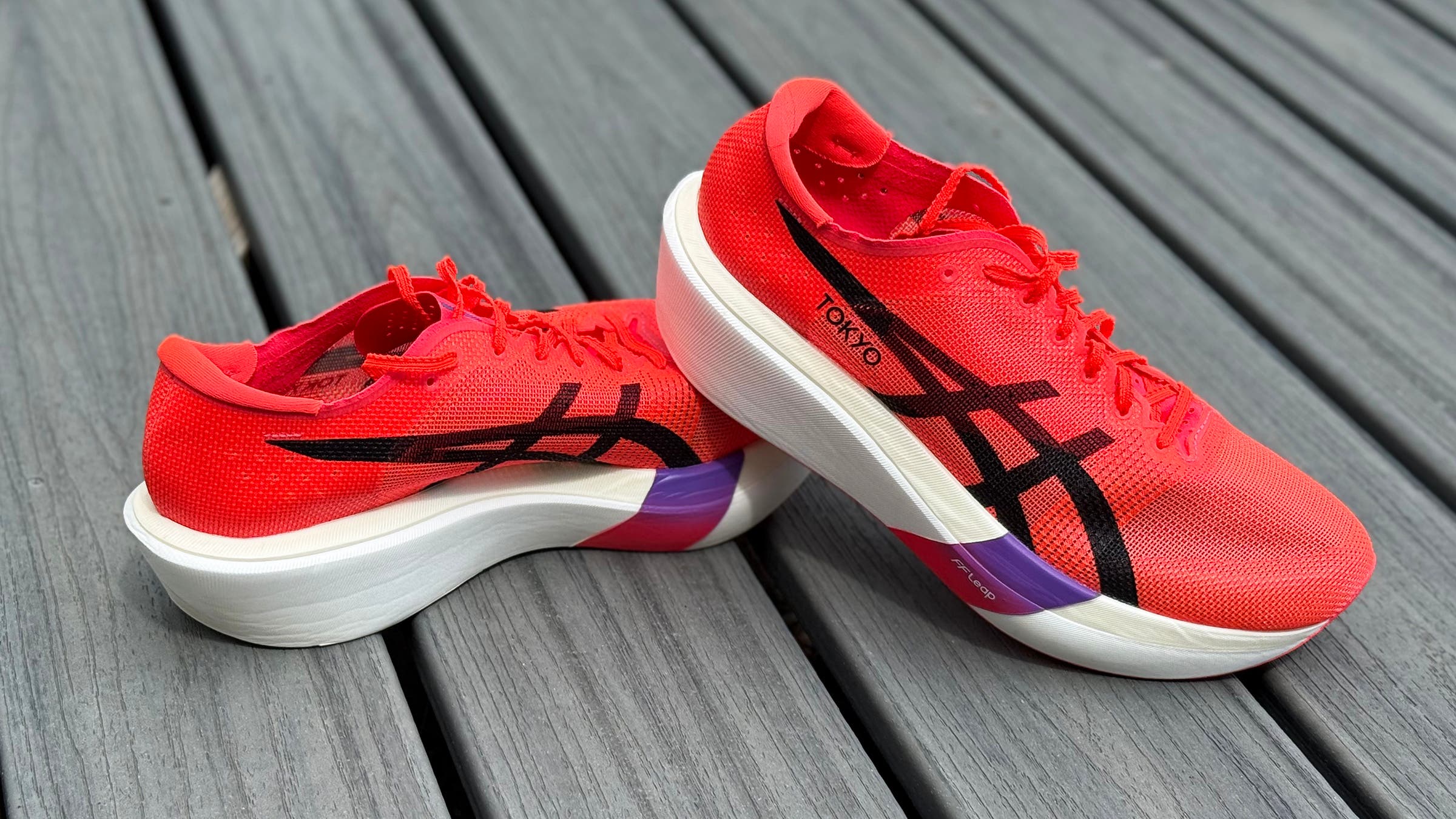
Runner-Up Best Marathon Racer
ASICS Metaspeed Sky Tokyo
Weight: 6.0 oz (men’s 9 and women’s 10.5)
Stack Height: 39.5-34.5mm
Drop: 5 mm
Sizing: 3.5-13, 14, 15 (men’s), 5-14.5, 15.5, 16.5 (women’s)
Pros and Cons
+ Wide forefoot provides stable stance
+ One of the lightest carbon fiber shoes
+ Comfortable, well-ventilated upper
– Can feel tippy at slower speeds and corners
A highly cushioned, bouncy, super shoe with a stable stance, the Asics Metaspeed Sky Tokyo ranks as one of the best road running shoes for marathon races. The dual-density midsole features a bottom layer of FF Leap, Asics’ newest A-TPU-based foam, claimed to be softer, bouncier, and more durable than its PEBA-based predecessor. On top is a slightly firmer foam, with a curved carbon fiber plate sandwiched between the two. Together, the foams strike a perfect balance between soft and reactive (the Outside Lab gave it a “soft score” of 5 on a scale of 1 to 10). As one tester said, ‘I don’t get lost in the compression and have to push myself out.”
Asics made this version of the Sky both bouncier and lighter, shedding over half an ounce to hit just six ounces in a men’s 9, making it one of the lightest super shoes available. Improvements in the upper, which uses a new lightweight, technical engineered woven mesh, give the Sky a comfortable and airy fit that one tester described as “barely there, yet enough security to stay in place.” Another found the minimal upper to “fit like the proverbial glove.”
The Sky’s geometry is designed for runners who increase their stride length as they run faster, but testers found it to be one of those rare super shoes that complements a wide range of gaits and footstrikes. “The foam and plate provide a smooth, long transition from heel to toe as my foot sinks into the soft, but not squishy stack, with a well-timed rebound just as I roll off the rocker for a powerful push off,” said one.
Read more about the Asics Metaspeed Sky Tokyo in our Super Shoe Showdown.
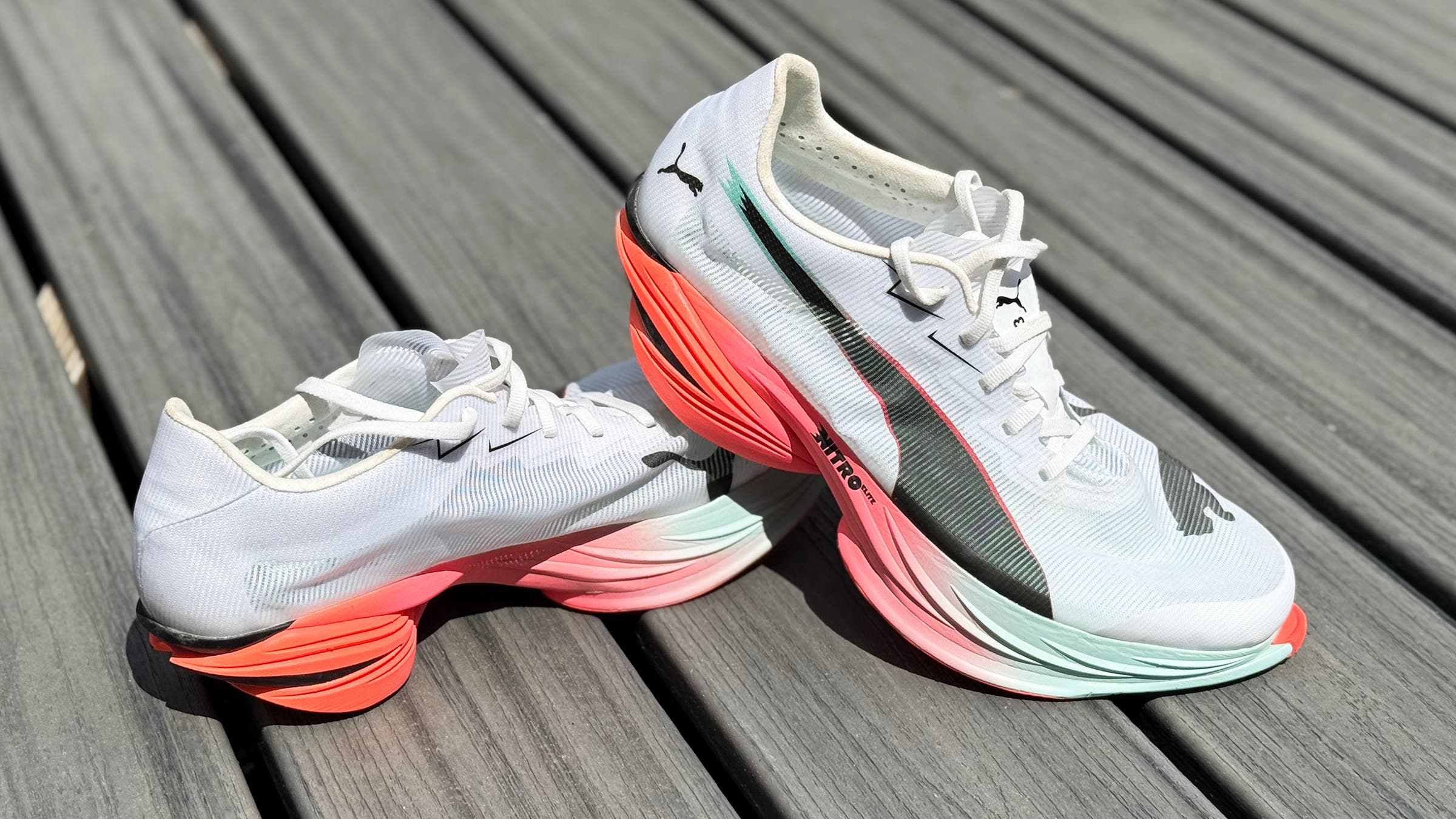
Best for Shorter Road Races
Puma Fast-R Nitro Elite 3
Weight: 6.0 oz (men), 4.8 oz (women)
Stack Height: 40-32 mm
Drop: 8 mm
Sizing: 7-11, 12, 13, 14(men’s), 5-11 (women’s)
Pros and Cons
+ One of the lightest carbon-plated shoes
+ Unmatched propulsive feel
+ Suitable for all distances
– Feels unstable at slower paces
– Quantities are limited and often sold out
Puma may not have the same caché in the running world as some other brands, but when they launched the updated Fast-R Nitro Elite 3, the entire industry took notice. Backed by a Puma-funded study that found the Fast-R3 to outperform its super shoe competitors by 3.15% to 3.62% in running economy, runners flocked to get their own pair of what we’ve determined is one of the best road running shoes for 5Ks and 10Ks.
The funky-looking design—which features a partially decoupled forefoot and heel and a carbon fiber plate that extends beyond the toe—may look unconventional, but it’s anything but frivolous. Every detail is carefully thought out and lab tested.
As the pioneer of using A-TPU foam in running shoes, Puma delivers a midsole that’s somewhat firm (rated 6 out of 10 for softness by the Outside Lab) but incredibly responsive and snappy. Puma cut away the midsole under the heel and through the midfoot to reduce weight where foam wasn’t needed. The exposed carbon fiber plate, with an early, aggressive rocker, acts as the backbone of energy transfer from heel to the extended forefoot. One tester described it as feeling “like a springboard, with smooth transitions.”
All testers agreed that at moderate paces, the road running shoe can be difficult to control. But once you’re driving off your toes, it truly comes alive. “I wasn’t impressed at jogging pace; the squishy heel (or lack thereof) feels mushy. But at marathon pace and faster, these provided the most propulsive toe-off of any shoe I’ve worn,” one said.
Strapping you to the midsole is an Ultraweave upper that’s so light and airy, it’s practically translucent. The only knock? The razor-thin tongue is flimsy and takes some effort to get it to lie flat.
Read more about the Puma Fast-R Nitro Elite 3 in our Super Shoe Showdown.
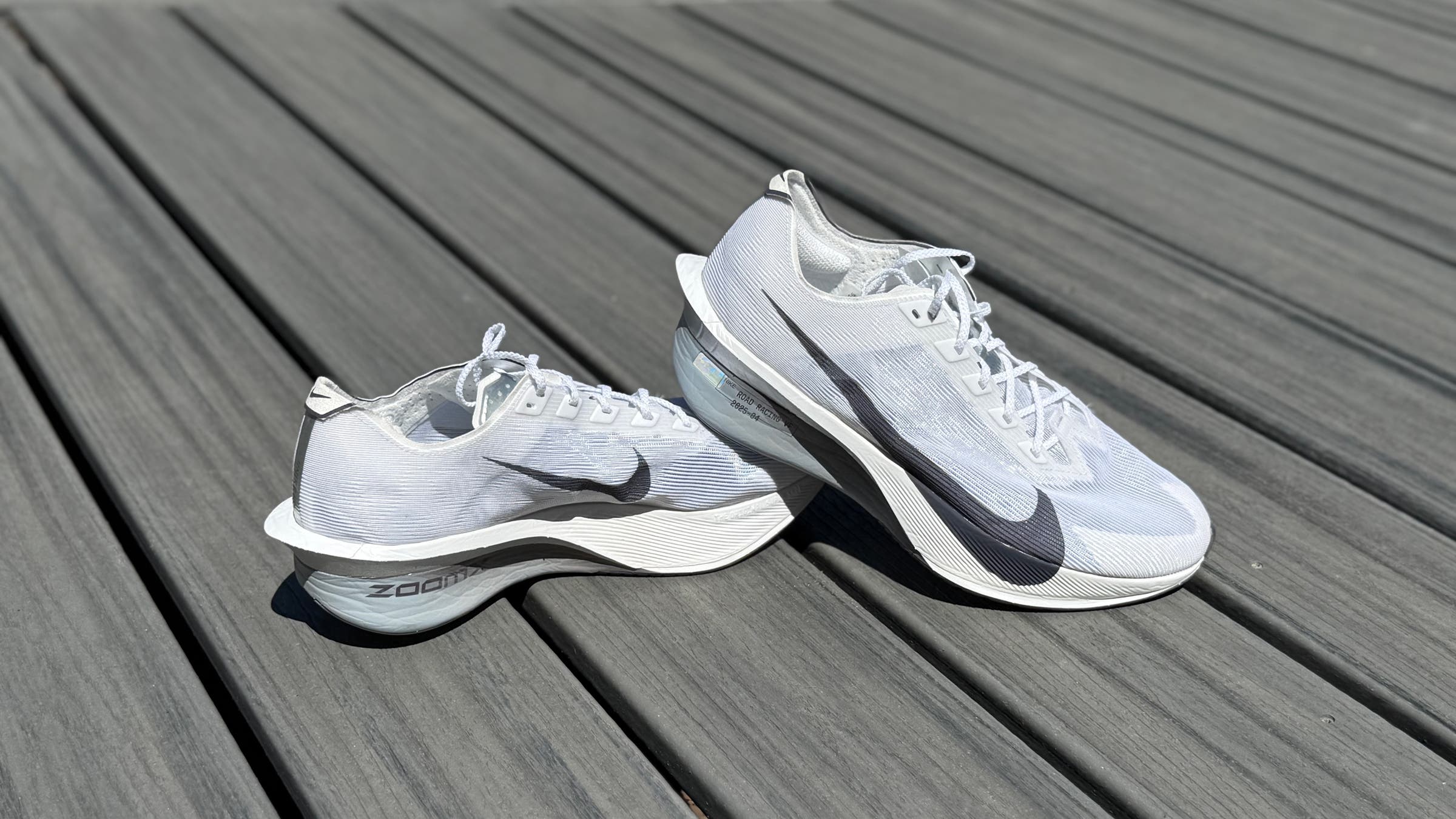
Runner-Up Best for Shorter Road Races
Nike Vaporfly 4
Weight: 6.7 oz (men’s 10), 5.4 oz (women)
Stack Height: 35-29 mm
Drop: 6 mm
Sizing: 6-13, 14, 15 (men’s), 5-12 (women’s)
Pros and Cons
+ Agile and lightweight
+ Exceptional foot hold
– Less cushioning underfoot than some prefer
The latest version of Nike’s original super shoe returns the Vaporfly to its lean and mean roots. With a reduced stack height of 35–29mm (down from 40–32mm), it’s an almost minimalist running shoe compared to every other super shoe, giving it an “agile and responsive” ride, as one elite tester said.
The Vaporfly 4 shares the same full-midsole ZoomX foam as its predecessor but features a redesigned carbon fiber plate with a three-degree steeper rocker curve, designed to enhance propulsion and efficiency. Our testers said the new geometry was not nearly as noticeable as the reduced stack, but did note the rocker felt steeper as it rolled off the toes, rewarding a forward-balanced stride.
Besides enhancing the shoe’s agility, reducing the amount of foam underfoot resulted in significant weight savings. It’s over an ounce lighter than the Vaporfly 3, and one of the lightest racers on the market.
The biggest improvement is the engineered mesh upper with stretchy sawtooth laces. Testers unanimously praised its form-fitting, comfortable, full-foot wrap.
While we wouldn’t recommend the Nike Vaporfly 4 for longer races for most runners, it’s one of the best road running shoes when you’re going at full speed during short races, like the mile and 5k. “I feel so fluid in this shoe—light on my toes, connected to the ground, and rolling through my stride,” one fast tester noted.
Read our full Nike Vaporfly 4 review.
How to Choose the Best Road Running Shoe for You
When choosing a road running shoe, the first step is to determine the type of running you’ll primarily be doing in them. Do you need a speedy racer, a shoe that offers comfort during long, slow jogs, or a versatile trainer that can handle various distances and paces?
Next, consider your preference for the feel of the shoe’s cushioning: do you like a soft, forgiving ride, a more energetic, bouncy sensation underfoot, or a firmer platform that provides better ground feel? With advancements in foams and technologies, many shoes today offer cushioning without compromising responsiveness or stability. However, each shoe balances these characteristics differently, providing a spectrum of options to choose from. The key to finding the perfect running shoe is choosing the one you’re most comfortable with.
Once you’ve narrowed the search to a certain type of road shoe, you need to find a pair that complements your unique body and stride. Every runner’s body, gait, speed, experience, and ride preferences are different, so every runner will interact differently with each running shoe. The shoe that your best friend or your sister-in-law loves may be uncomfortable for you and make running feel slow, sluggish, or even painful. Finding the perfect pair of road running shoes is a seriously personal affair.
The process for choosing the best running shoes is a matter of finding the models that both fit your foot and also feel best when you’re running. To determine fit and feel, there’s no substitute for trying the shoes on and running in them.
Fit: Match Your Foot Shape
When assessing fit, first pay attention to length. You need room at the end of your toes as your feet lengthen during their dynamic movements on the run. A rule of thumb is to allow a thumb’s width between your longest toe and the end of the shoe. Runners often wear a running shoe a half or full size bigger than their street shoes.
Ensure that the shape of the sole and the upper matches your foot shape. The sole should be as wide or wider than your foot for the whole length, and match the curve of your arch comfortably. The shoe should hold your foot securely over the instep, while allowing the ball of the foot and the toes to splay and flex when you roll forward onto them. Your heel shouldn’t slip when you lift it, and the arch should be able to dome and lengthen naturally. Nothing should bind or rub as you roll through the stride.
Feel: Match Your Movement Path
If the shoe fits, it’s time to take them on a short run on a treadmill, around the store, or, ideally, down the block and back. Every running shoe has a unique ride created by the type and density of foam in the midsole and the geometry of that foam: its thickness, width, heel-to-toe drop, molded sidewalls or flares, and forefoot flexibility or rocker shape (plus, in an increasing number of models, the presence of and type of embedded plate). Each of these elements interact with each other and your stride to determine how the shoe reacts on landing, how much it cushions, how stably it supports, how smoothly it transitions from landing to toe off, and how quickly and powerfully it rebounds.
The best way to choose the shoes that complement your body and stride is to find the ones that feel right on the run. Benno Nigg, the world-leading biomechanics professor who proposed this method of shoe selection, calls it the “comfort filter,” but makes clear it is far more than how plush the shoe feels when you step into it. What you want to assess is whether the shoe allows and supports the way your feet want to move, what Nigg calls your “preferred movement path.” In the right shoe, while running at your normal pace, you will touch down where you expect to land, roll smoothly and stably through the stride without noticing the shoe, feel both cushioned from and connected to the ground, and push off naturally, quickly, and powerfully. When this comes together you’ll know that you’ve found your pair.
It’s likely that several shoes will feel good on your feet. To find the most comfortable, it helps to compare them back to back, like an eye doctor will do with corrective lenses: flipping between “A” or “B,” “1” or “2.” You may also find that different shoes feel better at different paces or level of fatigue, and you may want more than one pair. In fact, research shows that wearing a variety of different shoes is one of the few proven ways to reduce injury risk as it appears to vary the stresses on your feet and joints.
What About Injury Prevention?
Running shoes have long been marketed and sold as prescriptive devices to help runners stay healthy, but there is little scientific evidence correlating shoes, or any specific shoe properties—like cushioning or pronation control—with running injuries. Medical professionals say that it is highly difficult to determine whether a runner needs a certain type of shoe, and studies have shown that prescribing shoes using traditional methods like treadmill gait analyses or wet-foot arch height tests don’t consistently reduce injuries.
Don’t assume that you need more cushioning or more stability if you have sore joints, or if you’re a heavier runner, or if you’re a beginner—evidence doesn’t support many common beliefs. The best way prevent injury is find two or three different pairs that feel right on the run, ease into using them, and vary your shoes, your running surface and your pace regularly (plus avoid rapid increases in your training load and work on improving your mechanics).
How We Test Road Running Shoes
- Number of testers: 23
- Number of shoes tested: 90
- Number of miles: 21,000+ over a year
To chose the best road running shoes, we begin by researching every brand’s upcoming offerings for the coming season. We wind up with dozens of samples of the models (51 road shoes this season, 90 over the year) that are most promising—not just for us, but for 23 testers that range in age, ability, running form, geographical location, and preferred shoe types. We try to put each tester in models from within the same category (e.g., neutral, stability, carbon fiber, zero drop or uptempo) so everyone can compare apples-to-apples.
After three to six months of running in each model on paved roads, concrete multi-use paths, treadmills, sandy beach paths, dirt roads, and tracks at a variety of distances, paces, and weather conditions, our crew members report back with their assessments of fit, comfort, traction, cushioning, flexibility, stiffness, pop, what type of running the model is best used for, how the shoe compares to other models, and more. We also run in every shoe ourselves, and, combining all the tester feedback with years of personal experience, hone in on the best. This guide combines the best recent shoes with outstanding shoes still available from the past two test periods.
Meet Our Lead Testers
Lisa Jhung
Freelance journalist, editor, and author Lisa Jhung has researched, tested, and written about running shoes for the past decade and a half, much of that time for Outside and Outside Buyer’s Guides. She coordinates a fleet of female shoe testers out of Boulder, Colorado, and says her home office is a perpetual obstacle course of cardboard boxes and piles of running shoes. Lisa’s written about gear of all kinds for numerous national magazines as both an editor and freelancer, including a stint as the Shoes & Gear blogger and trail running microsite editor for Runner’s World.
A high school jumper and occasional sprinter/hurdler, she started running—really running—after walking off the collegiate volleyball team, and moved on to road and trail races of any distance, triathlons, adventure races, and mountain running. She’s happiest testing rugged trail shoes on gnarly terrain, and also loves a good neighborhood jaunt…but is almost always looking for ribbons of dirt. Lisa is the author of Running That Doesn’t Suck: How to Love Running (Even If You Think You Hate It) and Trailhead: The Dirt on All Things Trail Running.
Cory Smith
Cory’s passion for running started over 30 years ago in high school when he became the number six ranked runner in the nation at 3000 meters his senior year. After high school, he competed at Villanova University, earning two NCAA Division I Championship showings. Today, he’s determined not to let age slow him down and competes on the national master’s circuit, running a 4:12 (4:30 mile pace)) 1500 meters and 9:04 (4:52 mile pace) 3000 meters in 2021 at age 43. He prefers a hard track workout or tempo run over an easy long run any day but also appreciates a challenging trail or mountain run.
His obsession with running shoes started in 2014 when he wrote his first shoe review for Gear Institute. Since then, he’s tested and reviewed hundreds of running shoes, clothing, and gear for Outside, Runner’s World, Footwear News, and other outlets. He has a soft spot for speedy shoes over heavy trainers but loves dissecting all shoes equally and thinking like a product engineer to explain the why behind every design detail. Cory is the Founder of Run Your Personal Best, an online running coaching business, and since its inception in 2014, has coached runners’ to over 100 Boston Marathon Qualifying times.
Here’s one of Cory’s shoe-testing routes on MapMyRun:
Jonathan Beverly
Jonathan fell in love with running his freshman year of high school and quickly became fascinated with finding the perfect pair of running shoes. That quest got a boost when he became editor of Running Times in 2000 and started receiving every new model as they were released. The parade of shoes continued while he served as shoe editor for Runner’s World, then editor of PodiumRunner, and currently fitness gear editor at Outside. Having now worn nearly every running shoe created in this century—and a fair amount of those dating back to the early models of the ’70s—he’s given up on finding the one best and now relishes the wide variety of excellent options.
Once a 2:46 marathoner regularly doing 50+ mile weeks, recent injuries and his age have reduced his volume by about half and slowed his easy training pace to around nine-minute miles—but he says he still enjoys an uptempo workout or two each week. Beverly is the author of the book Your Best Stride which explores how each individual’s gait—and, consequently shoe preference—is unique. He enjoys getting scientists’ take on new shoe trends and trying to describe the nuances of each shoe’s ride.